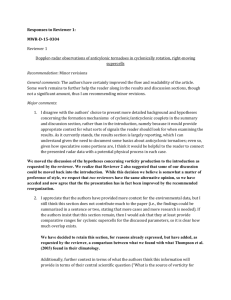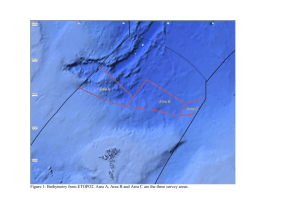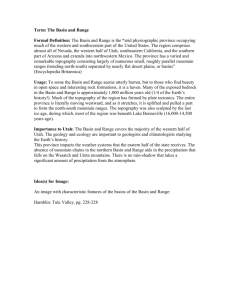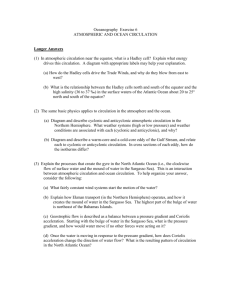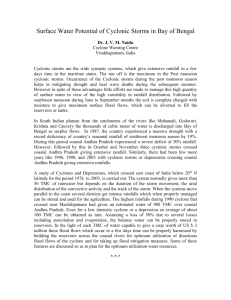Asymmetry of Free Circulations in Closed Ocean Gyres 517 J. H. L C
advertisement
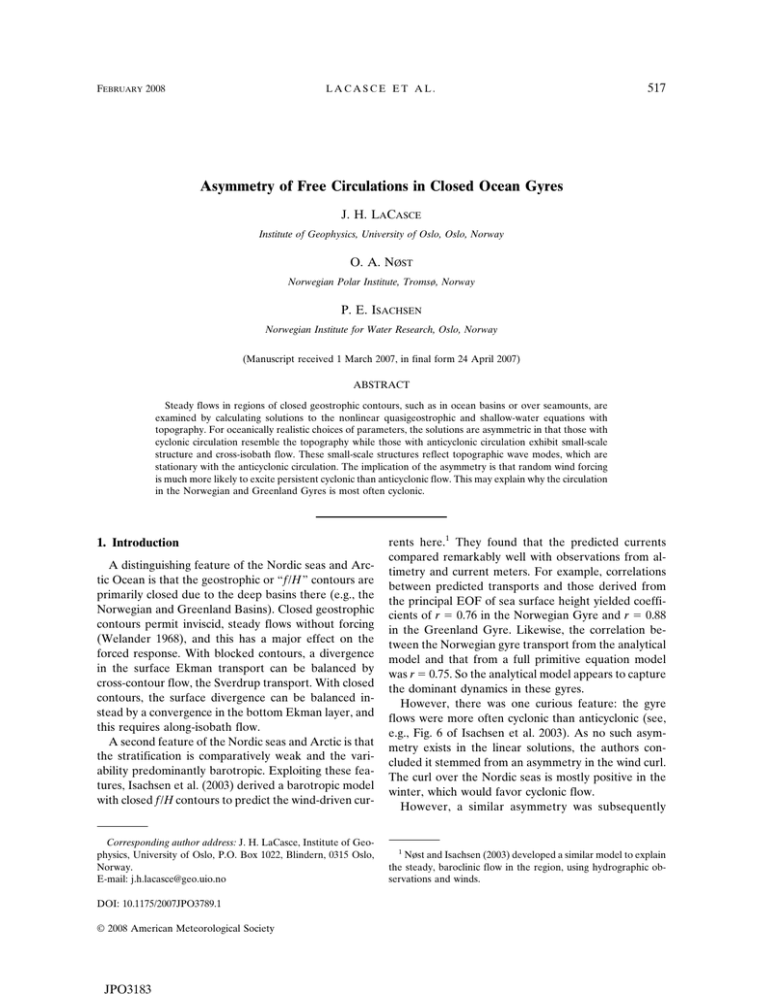
FEBRUARY 2008 LACASCE ET AL. 517 Asymmetry of Free Circulations in Closed Ocean Gyres J. H. LACASCE Institute of Geophysics, University of Oslo, Oslo, Norway O. A. NØST Norwegian Polar Institute, Tromsø, Norway P. E. ISACHSEN Norwegian Institute for Water Research, Oslo, Norway (Manuscript received 1 March 2007, in final form 24 April 2007) ABSTRACT Steady flows in regions of closed geostrophic contours, such as in ocean basins or over seamounts, are examined by calculating solutions to the nonlinear quasigeostrophic and shallow-water equations with topography. For oceanically realistic choices of parameters, the solutions are asymmetric in that those with cyclonic circulation resemble the topography while those with anticyclonic circulation exhibit small-scale structure and cross-isobath flow. These small-scale structures reflect topographic wave modes, which are stationary with the anticyclonic circulation. The implication of the asymmetry is that random wind forcing is much more likely to excite persistent cyclonic than anticyclonic flow. This may explain why the circulation in the Norwegian and Greenland Gyres is most often cyclonic. 1. Introduction A distinguishing feature of the Nordic seas and Arctic Ocean is that the geostrophic or “f /H ” contours are primarily closed due to the deep basins there (e.g., the Norwegian and Greenland Basins). Closed geostrophic contours permit inviscid, steady flows without forcing (Welander 1968), and this has a major effect on the forced response. With blocked contours, a divergence in the surface Ekman transport can be balanced by cross-contour flow, the Sverdrup transport. With closed contours, the surface divergence can be balanced instead by a convergence in the bottom Ekman layer, and this requires along-isobath flow. A second feature of the Nordic seas and Arctic is that the stratification is comparatively weak and the variability predominantly barotropic. Exploiting these features, Isachsen et al. (2003) derived a barotropic model with closed f /H contours to predict the wind-driven cur- Corresponding author address: J. H. LaCasce, Institute of Geophysics, University of Oslo, P.O. Box 1022, Blindern, 0315 Oslo, Norway. E-mail: j.h.lacasce@geo.uio.no DOI: 10.1175/2007JPO3789.1 © 2008 American Meteorological Society JPO3183 rents here.1 They found that the predicted currents compared remarkably well with observations from altimetry and current meters. For example, correlations between predicted transports and those derived from the principal EOF of sea surface height yielded coefficients of r ⫽ 0.76 in the Norwegian Gyre and r ⫽ 0.88 in the Greenland Gyre. Likewise, the correlation between the Norwegian gyre transport from the analytical model and that from a full primitive equation model was r ⫽ 0.75. So the analytical model appears to capture the dominant dynamics in these gyres. However, there was one curious feature: the gyre flows were more often cyclonic than anticyclonic (see, e.g., Fig. 6 of Isachsen et al. 2003). As no such asymmetry exists in the linear solutions, the authors concluded it stemmed from an asymmetry in the wind curl. The curl over the Nordic seas is mostly positive in the winter, which would favor cyclonic flow. However, a similar asymmetry was subsequently 1 Nøst and Isachsen (2003) developed a similar model to explain the steady, baroclinic flow in the region, using hydrographic observations and winds. 518 JOURNAL OF PHYSICAL OCEANOGRAPHY found in numerical experiments of flow over seamounts by Nycander and LaCasce (2004). In their spindown experiments, a wide range of initial states produced topography-following anticyclonic flows while none yielded cyclonic circulations. The only exception was in the special case of a perfectly circular seamount; then either sign circulation could result. The authors rationalized the asymmetry using nonlinear stability arguments (in the sense of Arnol’d 1966). In particular, only an anticyclonic flow over a seamount is demonstrably stable. Recently, Nøst et al. (2008) examined idealized basin flows in the laboratory and numerically. Unlike the spindown experiments of Nycander and LaCasce, these employed both surface forcing and bottom friction. The authors found that either anticyclonic or cyclonic flow could be obtained. Nevertheless, there were differences. While the cyclonic flows were strictly isobathfollowing, the anticyclonic flows exhibited regions of strong across-slope flow. Nøst et al. suggested the departures were a consequence of nonlinearity, as they appeared only when the bottom friction was weak (when the Rossby number was larger than the Ekman number). We see that Nøst et al.’s results are in line with the Isachsen et al. (2003) results, where there is no asymmetry, when the damping is strong and consistent with the Nycander and LaCasce (2004) experiments when the damping is weak. Nøst et al. (2008) also rationalized the asymmetry at larger Rossby numbers using nonlinear stability arguments. In this case, only a cyclonic basin flow is demonstrably stable. But, they also suggested another possible reason: that there is actually an asymmetry in the steady-state solutions. They argued in particular that the different sign flows would behave differently near topographic irregularities due to differences in the advection of relative vorticity. We demonstrate that there is, indeed, a difference in the steady solutions. While cyclonic basin solutions generally follow the topography, anticyclonic solutions have significant small-scale structure and diverge from the isobaths. So nonlinear stability need not come into play at all because large-scale forcing is much more likely to excite cyclonic steady flows than anticyclonic ones. 2. Theory Much of the background for this problem is laid out in the seminal work of Carnevale and Frederiksen (1987, hereafter CF). Flows with a small Rossby number and weak topographic variations conserve their quasigeostrophic (QG) potential vorticity in the absence of forcing or dissipation (Pedlosky 1987): 冉 VOLUME 38 冊 ⭸ ⭸ ⫹ u · 共ⵜ2 ⫹ h兲 ⫽ q ⫹ J共, q兲 ⫽ 0, ⭸t ⭸t 共1兲 where is the velocity streamfunction, q is the QG potential vorticity (PV), and J(·, ·) is the Jacobian function. Here the depth is written H共x, y兲 ⫽ H0 ⫺ 共x, y兲, under the rigid-lid assumption. QG requires that the nondimensional topographic height in (1), h ⫽ /H0 , is on the order of the Rossby number. Hereafter we consider vorticity variations due solely to the topography; that is, we neglect the variation of the Coriolis parameter.2 Equation (1) guarantees that all integrals of the form 冕冕 F 共q兲 dx dy 共2兲 are conserved, where F(q) is any function of the PV. The most familiar such function is the square of the PV, the potential enstrophy: 1 2 冕冕 q2 dx dy. 共3兲 From (1) it also follows that the energy is conserved: 1 2 冕冕 共兲2 dx dy. 共4兲 Based on the existence of these conserved quantities, the theory of Arnol’d (1966) can be used to prove the nonlinear stability of the stationary state given by q ⫽ ⵜ2 ⫹ h ⫽ , 共5兲 where is a constant. This solution represents one family of all the possible solutions to the steady version of (1): J共, q兲 ⫽ 0, 共6兲 which is satisfied by any flow for which q ⫽ F 共兲, 共7兲 where F can be any function, possibly a nonlinear one (Fofonoff 1954). Thus, relation (5) corresponds to having a linear F (). As shown by Fofonoff (1954), one can thus find solutions to the nonlinear problem (6) by solving a linear equation. The character of the solutions to (5) depends on the sign of . If is positive, (5) is like a diffusion equation, implying that the streamfunction 2 The present results pertaining to cyclonic/anticyclonic flows in a basin apply equally to anticyclonic/cyclonic flows over a seamount. We refer only to the basin case, for brevity. FEBRUARY 2008 LACASCE ET AL. will resemble the forcing function (the topography). If instead is negative, (6) is a Helmholtz equation and possesses normal mode solutions (like a drum). These modes can be excited “resonantly” by the topography for specific values of . Near such resonances, one expects very energetic flows. Solutions to (5) can be obtained easily following a Fourier transform. Consider a rectangular domain with sides Lx and Ly, where the streamfunction vanishes at the walls. Then we can write n⫽N m⫽M 共x, y兲 ⫽ 兺 兺 ˆ 共n, m兲 sin n⫽1 m⫽1 冉 冊 冉 冊 my nx sin , Lx Ly ĥ共n, m兲 共nⲐLx兲 ⫹ 共mⲐLy兲2 ⫹ 2 . In the limit of infinite resolution, the only stable solutions are those with as in (10). These have cyclonic circulation in a basin because the denominator of (9) is positive definite so that has the same sign as h.5 As argued above, these solutions should resemble the topography. Nonlinearity stability says nothing about the range for which ⫺共NⲐLx兲2 ⫺ 共MⲐLy兲2 ⬍ ⬍ ⫺共ⲐLx兲2 ⫺ 共ⲐLy兲2. 共12兲 共8兲 where N and M are the maximum wavenumbers resolved by the model. Transforming (5), we obtain ˆ 共n, m兲 ⫽ 519 共9兲 CF used Arnol’d’s (1966) method to show that the solutions to (9) with ⬎ ⫺共ⲐLx兲2 ⫺ 共ⲐLy兲2 共10兲 ⬍ ⫺共NⲐLx兲2 ⫺ 共MⲐLy兲2 共11兲 or are nonlinearly stable. The second condition (11) applies effectively to wavenumbers unresolved by the Fourier decomposition and thus becomes irrelevant as the grid size decreases to zero (i.e., as N, M → ⬁). Note also that as the scale of the domain is increased (Lx, Ly → ⬁), the first condition (10) implies simply that is positive. Steady solutions that satisfy (6) are extrema in that they correspond to the vanishing of the first variation of the energy (CF). Their stability is evaluated by examining the second variation. Solutions with in the two ranges shown above correspond to energy minima.3 Perturbing the state produces a positive definite change in the energy, implying that an arbitrary disturbance cannot grow in time without violating energy conservation.4 These solutions may be stable or not, depending on the character of the disturbances. The anticyclonic basin solutions occur in this range, as shown hereafter. Significantly, this range exhibits singularities because expression (9) is infinite when matches one of the squared wavenumbers. This was noted by CF and is expected for a Helmholtz-type equation, as noted above. Physically, the singularities represent topographic wave modes that are stationary for the given mean flow. Without a mean flow, there are an infinite set of topographic modes (e.g., Bokhove and Johnson 1999) and these exhibit cyclonic propagation, with shallow water to their right. As such, they can be stationary only in an anticyclonic mean flow. The gravest topographic mode is the fastest, and the higher modes have phase speeds that decrease monotonically with wavenumber. Thus the weaker the mean flow, the smaller the scale of the stationary mode. With infinite resolution there will always be a mode whose phase speed approximately matches the mean flow speed. But with finite resolution, one may obtain mean flows that are slower than the smallest resolved topographic mode [these correspond to the range of in (11)]. In the absence of damping, the flow will be very energetic in the vicinity of the topographic singularities. Thus we expect that cyclonic basin solutions should resemble the topography and are nonlinearly stable. The anticyclonic solutions, on the other hand, may or may not be stable and may not resemble the topography at all. 3. QG solutions 3 CF suggested incorrectly that the range in (11) corresponds to an energy maximum. However, this does not affect their conclusion with regard to the stability. 4 An alternate variational approach, used by Bretherton and Haidvogel (1976), is to minimize the enstrophy while keeping the energy constant. Their idea was to mimic the effect of twodimensional turbulence, where enstrophy is dissipated at small scales while energy is preserved at large scales. CF showed that solutions with (10) have minimum enstrophy while those with (11) have maximum enstrophy. We now examine the solutions to (5). As stated, these represent only a subset of the possibly infinite number of solutions to (6). We assume that the linear solutions, which are relatively easily obtained, are to some degree representative of the fuller set. The linear 5 Note that h is negative for a basin, implying a negative streamfunction and hence a positive vorticity, using our sign conventions. 520 JOURNAL OF PHYSICAL OCEANOGRAPHY VOLUME 38 FIG. 1. The total kinetic energy for an elliptical basin, plotted as a function of the parameter (solid line). The dashed line indicates the two-dimensional correlation between the streamfunction and the topography. The correlation is 1 for positive , indicating a topographyfollowing cyclonic flow. It approaches ⫺1 in the negative range between the singularities. solutions are, in addition, the relevant ones in terms of minimum enstrophy and maximum enstrophy considerations (CF). We obtained the solutions with various bottom topographies using the MATLAB and COMSOL Multiphysics software packages. We first consider an elliptical basin: 关⫺共xⲐDx兲2⫺共yⲐDy兲2兴 h共x, y兲 ⫽ ⫺Ae , 共13兲 with A ⫽ 0.3, Dx ⫽ 0.5, and Dy ⫽ 0.25. We use an elliptical basin because this is asymmetric in the sense discussed by Nycander and LaCasce (2004) and Nøst et al. (2008) (a circular basin is a special case because any azimuthally symmetric streamfunction is a solution to 6). In the MATLAB solutions, the basin was contained in a larger, rectangular basin with no normal flow through the walls. The COMSOL software uses a variable mesh and was configured to encompass only the elliptical basin. The results using the two approaches were nevertheless consistent. Solutions were obtained by varying over a range of values. We calculated the total kinetic energy of the solutions and plot the results in Fig. 1. The kinetic energy is greatest near the value of corresponding to the gravest mode in the system, as discussed below. It decreases monotonically for larger values of , while for negative values of there are discrete peaks. The latter are the topographic singularities discussed in section (2) and by CF. The peaks occur at wavenumbers n, m such that ⫽⫺ 冉 冊 冉 冊 n Lx 2 ⫺ m Ly 2 . 共14兲 The energy also decreases as becomes more negative, reflecting a weaker topographic projection, ĥ(n, m), at larger wavenumbers. Also plotted in Fig. 1 is the two-dimensional correlation between the topography and the streamfunction: 冕冕 冕 冕公 h dx dy c⫽ . 共15兲 h dx dy 2 2 For positive , the correlation approaches 1, indicating a cyclonic, isobath-following solution. For negative , the correlation varies substantially, approaching zero near the singularities and falling toward ⫺1 between the singularities. The latter is indicative of anticyclonic flow. Another way to determine the sign of the flow is simply to average the streamfunction. This is shown, as a function of , in Fig. 2. The resulting curve exhibits a single discontinuity. It is negative (cyclonic flow) for FEBRUARY 2008 521 LACASCE ET AL. tion is very like that in the upper-left panel, albeit weaker. The solution with ⫽ ⫺103 (lower-right panel) is quite different. There is a weak along-isobath background flow, which is anticyclonic, but superimposed on this are small-scale structures.6 These structures reflect the Fourier mode that is nearly singular. In this case, we could write ⫽ 共nⲐLx兲2 ⫹ 共mⲐLy兲2 ⫾ ␦, where n and m are much larger than one. Assuming ␦ is small, the streamfunction is dominated by that mode: ˆ 共n, m兲 ⫽ ⫾ FIG. 2. The mean streamfunction in an elliptical basin as a function of the parameter . larger values of and positive (anticyclonic flow) for lesser values. The singularity occurs at the wavenumber corresponding to the gravest mode in the system, which resembles the basin itself. We contour solutions with various values of in Fig. 3. The upper panels show two solutions with values of slightly greater and less than the transition value. In the cyclonic solution (upper-left panel of Fig. 3), the flow is predominantly along-isobath and the streamfunction closely resembles the basin. The same is true with the anticyclonic solution (upper-right panel). The solutions with near the critical value are therefore symmetric, with both anticyclonic and cyclonic solutions having predominantly along-isobath flow. These solutions can be understood as follows. If is on either side of the gravest mode, then we have ⫽ 共ⲐLx兲2 ⫹ 共ⲐLy兲2 ⫾ ␦. This implies, from (9), that ˆ 共1, 1兲 ⫽ ⫾ ĥ共1, 1兲 . ␦ 共16兲 Assuming ␦ K 1, the streamfunction will be large and will mirror the gravest mode. As the gravest mode resembles the basin itself, we obtain approximately isobath-following flow. The lower panels show two solutions with far from the streamfunction transition value. The solution with ⫽ 103 (lower-left panel) is cyclonic and the flow is again predominantly along-isobath. In this case, the gravest mode, ĥ(1, 1), dominates the transform, but the large value of weakens the amplitude. So, the solu- ĥ共n, m兲 . ␦ 共17兲 As before, the sign of ˆ (n, m) is the same as that of ␦. The difference is that this is a much higher mode, so changing the sign simply turns the small-scale cyclones to anticyclones, and vice versa. Unlike with the corresponding cyclonic solution, the basin-average kinetic energy for the negative solution is usually large, due to the singularities. However, because the singularities have a sinusoidal structure, with both positive and negative signs, their basin average is approximately zero. So the average streamfunction reflects instead the anticyclonic background. This explains the discrepancy between the kinetic energy diagram in Fig. 1 and the mean streamfunction curve in Fig. 2. There are regions of the kinetic energy curve between the singularities where the energy falls to lower values. As can be deduced from the correlation curve in Fig. 1, these flows are more dominated by the alongisobath component. However, the small-scale structures are generally visible and prevent the correlation from relaxing completely to ⫺1. So the cross-isobath flow is essentially always present in the anticyclonic range. In addition, the spacing between the singularities decreases to zero in the limit of a large domain (Lx, Ly → ⬁), so the relevance of these gap regions in more realistic settings is likely to be minor. Thus for most values of less than the streamfunction transition value, the anticyclonic mean states are contaminated by small-scale structures. The important question then is what range of is realistic for the ocean? If is typically small, the solutions will lie near the gravest topographic mode and the solutions would be approximately symmetric. To see, we turn to the 6 Similar structures were noted in the Fofonoff-like solutions in a flat-bottom, -plane basin by Marshall and Marshall (1992). 522 JOURNAL OF PHYSICAL OCEANOGRAPHY VOLUME 38 FIG. 3. The solutions to (5) with various values of : (top) solutions near the critical value of , where there is a transition from cyclonic to anticyclonic flow in Fig. 2, and (bottom) far from the critical value. (left) Cyclonic and (upper right) anticyclonic flow. (lower right) Superposition of a weak anticyclonic background flow with small-scale features. shallow-water formulation of the problem, which permits realistic topographic variations. Q⫽ Q⫽ The conservation of potential vorticity in the shallow-water (SW) system with a rigid lid can be written 冉 冊冉 冊 冉 冊 ⫹f ⭸ ⬅ ⫹ u · Q ⫽ 0, H ⭸t or 共18兲 where ⫽ ⭸ ⭸ ⫺ u ⭸x ⭸y is the relative vorticity, H ⫽ H(x, y) is the water depth, and Q is the SW potential vorticity. The continuity equation is · 共Hu兲 ⫽ 0. 共19兲 So the steady version of (18) can be written J共⌿, Q兲 ⫽ 0, 共21兲 Following section (3), we will focus on the linear version of (21): 4. Shallow-water solutions ⭸ ⫹u· ⭸t ⫹f ⫽ F 共⌿兲. H 共20兲 where ⌿ is the transport streamfunction. Solutions to this have · · 共⌿ⲐH兲 ⫹ f ⫽ ⌿ H 冉 冊 ⌿ ⫺ H⌿ ⫽ ⫺f. H 共22兲 共23兲 It is straightforward to show that we recover the QG version of the problem, (5), if the (scaled) vorticity and topographic variations are O(Ro) and if H 2f (⫺1)UL → . We obtained solutions to (23), again using the COMSOL software package. In keeping with the preceding section, we first examine an elliptical basin. The basin was 1000 m deep with dimensions of 200 km by 100 km. The mean streamfunction (not shown) exhibited the same parametric dependence as the QG calculation, with a single discontinuity separating cyclonic solutions for positive and anticyclonic ones for negative . Examples of the solutions are shown in Fig. 4. The upper panels correspond to solutions near the streamfunction singularity (with ⫽ ⫾10⫺14). The cyclonic FEBRUARY 2008 LACASCE ET AL. 523 FIG. 4. The solutions to (23) with a 50-km-wide elliptical basin: (left) cyclonic and (right) anticyclonic circulation. The solutions have as indicated. solution is nearly isobath-following, while the anticyclonic solution already deviates significantly from the isobaths. The tendency as one moves away from the singularity is as in the QG solutions. With ⫽ 10⫺13, the cyclonic solution follows the topography while the anticyclonic one exhibits small-scale structures. With ⫽ 10⫺12 (lowest panels), the anticyclonic solution is riddled with small structures. The central point of interest though is the magnitude of the velocities. The best way to gauge these is to use the cyclonic solutions because the velocities decrease monotonically with increasing . With ⫽ 10⫺14 (the upper panels), the maximum velocities are roughly 1.5 m s⫺1. With ⫽ 10⫺13, they are 55 cm s⫺1 and with ⫽ 10⫺12 they are 20 cm s⫺1. So the solutions that are most “realistic” for oceanic flows are those with || ⬇ 10⫺12. We calculated additional solutions, with more realistic topography. For this we used the Nordic seas topography, derived from 5-minute gridded elevations/ bathymetry for the world (ETOPO5) and modified to lie in a square domain (we set all depths less than 750 m equal to 750 m and enclosed the resulting basin with square “walls”). In reality the contours corresponding to depths less than 750 m extend into the Arctic and out into the North Atlantic, but as we are interested in the flow in the three enclosed gyres (the Norwegian, the Greenland, and the Lofoten), this representation suffices. The flows with various are shown in Figs. 5 and 6. With ⫽ 10⫺17 (upper left panel of Fig. 5), the cyclonic solution has intensified flow in the regions of the three gyres. The anticyclonic solution (right panel), on the other hand, deviates significantly from the topography. With ⫽ ⫾10⫺16 (lower panels), the cyclonic solution has three recognizable gyres, while the anticyclonic solution has significant small-scale structure. Decreasing further (Fig. 6) yields even smaller scales in the anticyclonic solutions. Again, we can gauge the strength of the flows by examining the maximum velocities in the cyclonic solutions. With ⫽ 10⫺17, the maximum velocities are roughly 15 m s⫺1 (a respectable value even by atmo- 524 JOURNAL OF PHYSICAL OCEANOGRAPHY VOLUME 38 FIG. 5. The solutions to (23) with a representation of the topography of the Nordic seas: (left) cyclonic and (right) anticyclonic circulation for (top) ⫽ ⫾10⫺17 and (bottom) ⫽ ⫾10⫺16. Depth contours less than 750-m depth have been set to 750 m. spheric standards). For ⫽ 10⫺16 the maximum is about 4.5 m s⫺1, while at ⫽ 10⫺15 it is 1.2 m s⫺1. The maximum with ⫽ 10⫺14 is 30 cm s⫺1.7 As noted earlier, these velocities relate to the phase speeds of the corresponding topographic modes. The small- solutions correspond to the gravest modes, with the fastest phase speeds. The speeds are evidently on 7 A prominent feature of the cyclonic solutions is the very energetic flow around the island of Jan Mayen, near the center of the domain. We excluded this when estimating the maximum velocities but the maximum here with ⫽ 10⫺14 is over 1 m s⫺1. In the present context Jan Mayen is a seamount, with anticyclonic flow, and the velocities are large because the topography is steep. Such an intense flow is probably unrealistic and is perhaps limited by bottom friction. the order of meters per second for these basins. The higher modes have smaller speeds and, of course, more small-scale structure. So wind forcing that would produce 30 cm s⫺1 velocities or less would excite solutions with ⬇ 10⫺14. Of course the velocities in the anticyclonic solutions do not decrease monotonically with decreasing due to the energetic contribution from the small scales. Nevertheless, wind forcing that would produce a 30 cm s⫺1 alongisobath anticyclonic flow would necessarily be compared to the solution with ⫽ 10⫺14. This solution is far from isobath-following. 5. Discussion Steady solutions in closed basins that are of realistic strength are asymmetric in that cyclonic solutions are FEBRUARY 2008 LACASCE ET AL. 525 FIG. 6. The solutions to (23) with the Nordic seas topography: (top) ⫽ ⫾10⫺15 and (bottom) ⫽ ⫾10⫺14. nearly isobath-following, while anticyclonic solutions exhibit small-scale structure and cross-isobath flow. The small-scale structure reflects stationary topographic wave modes, which due to their cyclonic propagation necessarily occur with anticyclonic mean flows. Similar comments apply with seamount-trapped flows with the signs of the circulation reversed. This sign asymmetry is not present in the linear equations of motion where any topography-following flow is steady. The linear form of Eq. (5), which neglects the relative vorticity contribution, has solutions that are just functions of the topography and can have either sign. The nonlinear case opens the possibility of the coexistence of a mean flow and topographic modes. The linear solutions, in fact, correspond to the nonlinear solutions with large positive values of , or large negative values of between the singularities. As we have seen, the latter are tightly clustered, and we rarely find instances of anticyclonic flow without small-scale structure. In a linear stability analysis of a basintrapped flow, one would likely start with topographyfollowing flow. But such a flow in the anticyclonic case is difficult to find. Nevertheless, forcing can produce anticyclonic basin flows (Isachsen et al. 2003; Nøst et al. 2008). Nøst et al. (2008) found that the streamlines in such cases diverged from the isobaths in localized regions (see, e.g., their Fig. 8) but otherwise followed the topography. This implies that the balance of forcing and dissipation, integrated over the closed contours, is selecting a certain circulation. The present results however tell us how the systems will behave once the forcing is switched off. If 526 JOURNAL OF PHYSICAL OCEANOGRAPHY the flow is similar to a free solution, it ought to persist, spinning down due to bottom friction. The anticyclonic forced solutions, on the other hand, would necessarily evolve in time, not being near a steady solution. We emphasize that the breakup of the anticyclonic flow occurs because the flow is not steady, not due to instability. Of course, the wind could excite one of the free anticyclonic modes if it had precisely the same small-scale structure as the mode (e.g., as in Fig. 6). This is a fairly unlikely event. But if this were to occur, the flow would likely be unstable in any case. Interestingly, there is a possibility of obtaining weak, topography-following, anticyclonic circulations in numerical models with finite resolution. This will occur for flow in which the mean speed is slower than that of the smallest resolved topographic mode (corresponding to the range of shown in 11, as noted by CF). So coarse-resolution ocean models will permit steady anticyclonic circulations that would otherwise not exist. As these unresolved solutions are also Arnol’d stable (CF), they could persist for long periods of time. It is thus worth checking such model results with higherresolution experiments. This study was motivated by considerations of the Nordic seas, where the stratification is relatively weak, but the asymmetry could be expected to carry over to the stratified case as well. In this case, the topographic waves would be bottom-intensified. But they would still propagate cyclonically in a basin, and thus could be stationary only in an anticyclonic flow. VOLUME 38 Acknowledgments. We are grateful to George Carnevale, Johan Nilsson, and two anonymous reviewers for their comments. REFERENCES Arnol’d, V. I., 1966: On an a priori estimate in the theory of hydrodynamic stability. Izv. Vyssh. Uchebn. Zaved. Matematika, 54 (5), 3–5. Bokhove, O., and E. R. Johnson, 1999: Hybrid coastal and interior modes for two-dimensional homogeneous flow in a cylindrical ocean. J. Phys. Oceanogr., 29, 93–118. Bretherton, F. P., and D. B. Haidvogel, 1976: Two-dimensional turbulence over topography. J. Fluid Mech., 78, 129–154. Carnevale, G. F., and J. S. Frederiksen, 1987: Nonlinear stability and statistical mechanics of flow over topography. J. Fluid Mech., 175, 157–181. Fofonoff, N. P., 1954: Steady flow in a frictionless homogeneous ocean. J. Mar. Res., 13, 254–262. Isachsen, P. E., J. H. LaCasce, C. Mauritzen, and S. Häkkinen, 2003: Wind-driven variability of the large-scale recirculating flow in the Nordic seas and Arctic Ocean. J. Phys. Oceanogr., 33, 2534–2550. Marshall, D., and J. Marshall, 1992: Zonal penetration scale of midlatitude oceanic jets. J. Phys. Oceanogr., 22, 1018–1032. Nøst, O. A., and P. E. Isachsen, 2003: The large-scale time-mean ocean circulation in the Nordic seas and Arctic Ocean estimated from simplified dynamics. J. Mar. Res., 61, 175–210. ——, J. Nilsson, and J. Nycander, 2008: On the asymmetry between cyclonic and anticyclonic flow in basins with sloping boundaries. J. Phys. Oceanogr., in press. Nycander, J., and J. H. LaCasce, 2004: Stable and unstable vortices attached to seamounts. J. Fluid Mech., 507, 71–94. Pedlosky, J., 1987: Geophysical Fluid Dynamics. Springer-Verlag, 728 pp. Welander, P., 1968: Wind-driven circulation in one- and two-layer oceans of variable depth. Tellus, 20, 1–15.
